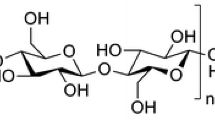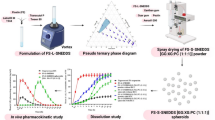Abstract
The polyelectrolyte complex (PEC) hydrogel beads based on chitosan (CS) and carrageenan (CR) have been studied as a controlled release device to deliver sodium diclofenac (DFNa) in the simulated gastrointestinal condition. Various factors potentially influencing the drug release (ie, CS/CR proportion, DFNa content, types and amount of cross-linking agents) were also investigated. The optimal formulation was obtained with CS/CR proportion of 2/1 and 5% (wt/vol) DFNa. The controlled release of the drug from this formulation was superior to other formulations and was able to maintain the release for ∼8 hours. Upon cross-linking with glutaric acid and glutaraldehyde, the resulting beads were found to be more efficient for prolonged drug release than their non-cross-linking counterparts. The bead cross-linked with glutaraldehyde was able to control the release of the drug over 24 hours. The difference in the drug release behavior can be attributed to the differences in ionic interaction between the oppositely charged ions and to the concentrations of the drug within the beads, which depends on the compositions of the formulation and the pH of the dissolution medium. The release of drug was controlled by the mechanism of the dissolution of DFNa in the dissolution medium and the diffusion of DFNa through the hydrogel beads.
Similar content being viewed by others
References
Peppas NA. Hydrogels and drug delivery.J. Microbiol Methods. 1997;2:531–537.
Skåk-Bræk G, Anthonsen T, Sandford P, eds.Chitin and Chitosan: Sources, Chemistry, Biochemistry, Physical Properties and Applications. London, UK: Elsevier; 1989:657–663.
Gebelein CG, Dunn RL, eds.Progress in Biomedical Polymers. New York, NY: Plenum Press; 1990:283–289.
Tozaki H, Komoike J, Tada C, et al. Chitosan capsules for colon specific drug delivery: improvement of insulin absorption from the rat colon.J Pharm Sci. 1997;86:1016–1021.
González-Rodríguez ML, Holgado MA, Sánchez-Lafuente C, Rabasco AM, Fini A. Alginate/chitosan particulate systems for sodium diclofenac release.Int J Pharm. 2002;232:225–234.
Remuňán-López C, Lorenzo-Lamosa ML, Vila-Jato JL, Alonso MJ. Development of new chitosan-cellulose multicore microparticles for controlled drug delivery.Eur J Pharm Biopharm. 1998;45:49–56.
Kim TK, Park YH, Kim KJ, Cho CS. Release of albumin from chitosan-coated pectin beads in vitro.Int J Pharm. 2003;250:371–383.
Torre PM, Enobakhare Y, Torrado G, Torrado S. Release of amoxicillin from polyionic complexes of chitosan and poly(acrylic acid) study of polymer/polymer and polymer/drug interactions within the network structure.Biomaterials. 2003;24:1499–1506.
Sanli O, Ay N, Isiklan N. Release characteristics of diclofenac sodium from poly(vinyl alcohol)/sodium alginate and poly(vinyl alcohol)-grafted poly(acrylamide)/sodium alginate blend beads.Eur J Pharm Biopharm. 2007;65:204–214.
Sipahigil O, Gursoy A, Cakalagaoglu F, Okar I. Release behaviour and biocompatibility of drug-loaded pH sensitive particles.Int J Pharm. 2006;311:130–138.
Gupta VK, Hariharan M, Wheatley TA, Price JC. Controlled-release tablets from carrageenans: effect of formulation, storage and dissolution factors.Eur J Pharm Biopharm. 2001;51:241–248.
Tomida H, Nakamura C, Kiryu S. A novel method for the preparation of controlled-release theophylline capsules coated with a polyelectrolyte complex of k-carrageenan and chitosan.Chem Pharm Bull (Tokyo). 1994;42:979–981.
Tapia C, Escobar Z, Costa E, et al. Comparative studies on polyelectrolyte complexes and mixture of chitosan-alginate and chitosan-carrageenan as prolonged diltiazem clorhydrate release system.Eur J Pharm Biopharm. 2004;57:65–75.
Genta I, Constantini M, Asti A, Conti B, Montanari L. Influence of glutaraldehyde on drug release and mucoadhesive properties of chitosan microspheres.Carbohydr Polym. 1998;36:81–88.
Bodnar M, Hartmann JF. Preparation and characterization of chitosan-based nanoparticles.Biomacromolecules. 2005;6:2521–2527.
Gillman AG, Nies TW, Taylor P.The Pharmacological Basis of Therapeutics. New York, NY: Pergamon Press.
Sankalia MG, Mashru RC, Sankalia JM, Sutariya VB. Papain entrapment in alginate beads for stability improvement and site-specific delivery: physicochemical characterization and factorial optimization using neural network modeling.AAPS PharmSciTech. 2005;6:E209-E222.
Kurkuri MD, Aminabhavi TM. Poly(vinyl alcohol) and poly(acrylic acid) sequential interpenetrating network pH-sensitive microspheres for the delivery of diclofenac sodium to the intestine.J Control Release. 2004;96:9–20.
Shu XZ, Zhu KJ. Controlled drug release properties of ionically cross-linked chitosan beads: influence of anion structure.Int J Pharm. 2002;233:217–225.
Cassidy MB, Lee H, Trevors JT. Survival and activity of lac-lux marked Pseudomonas aeruginosa UG2Lr cells encapsulated in k-carrageenan over four years at 4°C.J Microbiol Methods. 1997;30:167–170.
López A, Lázaro N, Marqués M. The interphase technique: a simple method of cell immobilization in gel-beads.J Microbiol Methods. 1997;30:231–234.
Maciel JS, Silva DA, Haroldo CBP, de Paula RCM. Chitosan/carboxymethyl cashew gum polyelectrolyte complex: synthesis and thermal stability.Eur Polym J. 2005;41:2726–2733.
Puttipipatkhachorn S, Pongjanyakul T, Priprem A. Molecular interaction in alginate beads reinforced with sodium starch glycolate or magnesium aluminum silicate, and their physical characteristic.Int J Pharm. 2005;293:51–62.
Sakiyama T, Chu CH, Fujii T, Yano T. Preparation of a polyelectrolyte complex gel from chitosan and k-carrageenan and its pH-sensitive swelling.J Appl Polym Sci. 1993;50:2021–2025.
Sheu M, Chou H, Kao C, Liu C, Sokoloski TD. Dissolution of diclofenac sodium from matrix tablets.Int J Pharm. 1992;85:57–63.
Kincl M, Vrečer F, Veber M. Characterization of factors affecting the release of low-solubility drug from prolonged release tablets.Anal Chem Acta. 2004;502:107–113.
Author information
Authors and Affiliations
Corresponding author
Additional information
Published: November 16, 2007
Rights and permissions
About this article
Cite this article
Piyakulawat, P., Praphairaksit, N., Chantarasiri, N. et al. Preparation and evaluation of chitosan/carrageenan beads for controlled release of sodium diclofenac. AAPS PharmSciTech 8, 97 (2007). https://doi.org/10.1208/pt0804097
Received:
Revised:
Accepted:
DOI: https://doi.org/10.1208/pt0804097




